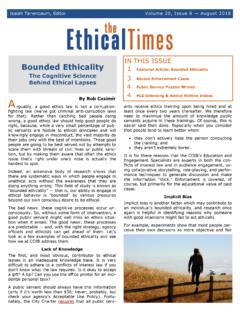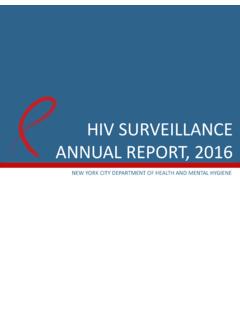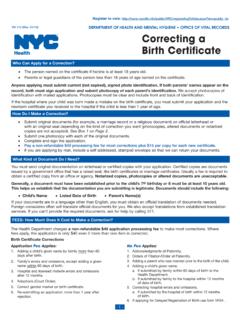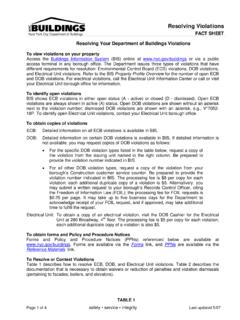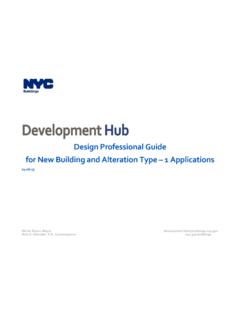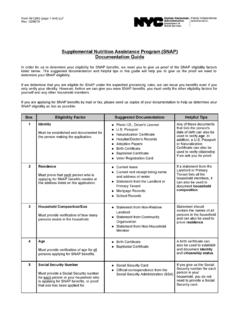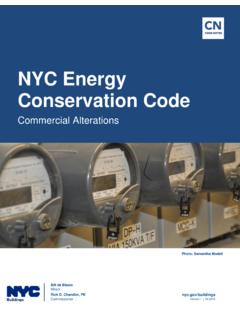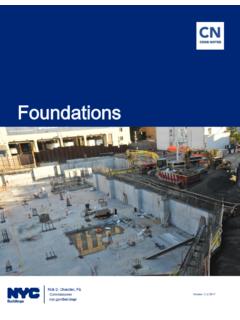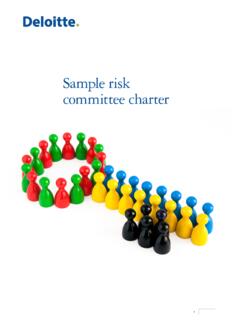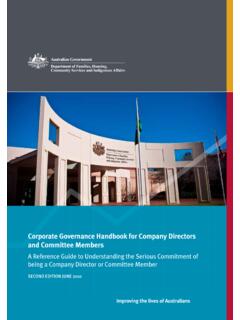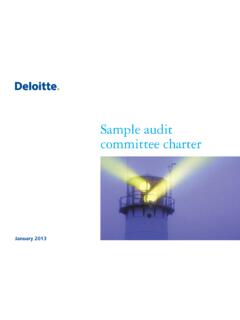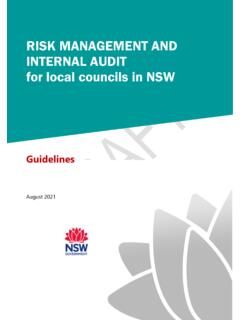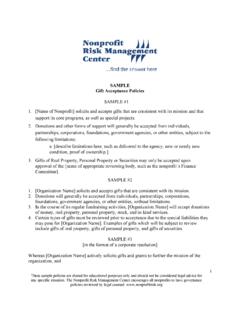Transcription of B CITY OF NEW YORK
1 1 BOARD OF CORRECTION CITY OF NEW YORK Notice of Adoption of Rules Notice is hereby given in accordance with section 1043(f) of the New York City charter that the Board of Correction is adopting rules relating to the use of restrictive housing in facilities operated by the Department of Correction. These rules are promulgated pursuant to sections 1043 and 626 of the New York City charter . On April 13 and April 14 2021, the Board of Correction held electronic public hearings on these rules. On June __, 2021, the Board of Correction approved these rules at a public meeting also held electronically. STATEMENT OF BASIS AND PURPOSE Under 626 of the New York City charter , the Board of Correction ( Board or BOC ) is authorized to establish minimum standards for the care, custody, correction, treatment, supervision, and discipline of all persons held or confined under the jurisdiction of the New York City Department of Correction ( Department or DOC ).
2 Pursuant to this authority, the Board hereby creates a new chapter 6 of its rules and amends certain existing rules, designed to ensure that people in the Department of Correction s custody: (1) are placed in restrictive housing in accordance with due process and procedural justice principles; and (2) are confined in the least restrictive setting and for the least amount of time necessary to address the specific reasons for their placement and to ensure their own safety as well as the safety of staff, other people in custody, and the public. Notably, these rules end the inhumane practice of solitary confinement (also referred to as punitive segregation or PSEG ) in the New York City jails, replacing it with a more humane alternative that still holds people accountable for the commission of serious offenses in custody.
3 In contrast to PSEG, the new model known as the Risk Management and Accountability System ( RMAS ) guarantees that people in custody who have committed serious offenses in jail still receive at least 10 hours outside of their cell per day with some opportunity for socialization. The rules also prohibit the Department from routinely shackling people during their time out of cell. From Reforms to Rules 2 In just five years 2014 through 2018 the New York City jail system underwent groundbreaking reforms. These critical changes spurred a period of innovation and experimentation as the Department, under the oversight of the Board, developed alternatives to punitive segregation, alternative ways to reduce violence in the jails, and alternative strategies to manage its adolescent and young adult populations.
4 Implementation of reforms required DOC to seek variances ( temporary exceptions) from the Minimum Standards and led to the Board s imposition of conditions on granting the variances. In January 2015, the Board enacted historic amendments to its Minimum Standards: namely, limitations on the use of punitive segregation ( PSEG )1 and the creation of enhanced supervision housing ( ESH )2 for adults as part of systemic reforms in the City jails. The reforms included the elimination of PSEG for 16 to 21-year-olds and individuals with serious mental or serious physical disabilities or Approximately one year later, in December 2015, BOC enacted further amendments, including some proposed by DOC, such as the 60-day sentence for assaults on staff. The Department achieved elimination of PSEG for adolescents ( , people ages 16 and 17) in December 2014 and for young adults ( , people ages 18 through 21) in October 2016.
5 Just two years later, in October 2018, DOC achieved another milestone the transfer of adolescents off Rikers Island to the Horizon Juvenile Center in the Bronx, under the joint care of DOC and The elimination of punitive segregation for young people led the Department to establish alternative restrictive housing for the young adult jail population: Second Chance Housing Unit ( Second Chance ), Transitional Restorative Unit ( TRU ), Secure Unit ( Secure ), and Young Adult ESH ( YA-ESH ). During this period of reform, the Department commingled young adults with adults in certain ESH units, implemented the routine use of restraint desks in ESH Level 1 during all lock-out time, and operated a highly restrictive unit in West Facility without affording due process to the adults and young adults placed there.
6 The Board viewed these actions as running counter to basic tenets underlying the Department s Young Adult Plan5, the PSEG amendments, and the intended purposes of ESH. This retrenchment of the 2014-2015 reforms led to variances and 1 Minimum Standard ( Min. Std. ) 1-17 ( Limitations on the Use of Punitive Segregation ). 2 Min. Std. 1-16 ( Enhanced Supervision Housing ). 3 Min. Std. 1-17(b)(iii) ( Exclusions ). 4 ACS is the NYC Administration for Children s Services. As of October 1, 2020, adolescents are in the sole custody of ACS. 5 In 2016, the Department of Correction put forth a plan to account for the developmental differences of the Young Adult population and their overall well-being while in custody. This plan included the following goals: removing all Young Adults from Punitive Segregation; housing Young Adults separately from adults; creating alternatives to Punitive Segregation housing; training all steady officers assigned to Young Adult housing in Safe Crisis Management; training all steady officers assigned to alternative housing units in Cognitive Behavioral Therapy; and providing a minimum of 5 hours of programming per day for Young Adults in the general population.
7 3 variance conditions, most of which continue to the present day. It also led to the Board s unanimous vote in 2016 to conduct rulemaking on restrictive 2019 Board Vote on Proposed Rules On October 31, 2019, the Board voted to formally propose restrictive housing rules ( 2019 Rule ), which were the result of extensive fact-finding in 2017-2018. This included discussions with 30 organizations and individuals the local defense bar, criminal justice advocates, national criminal justice organizations and oversight entities, Correction Officers Benevolent Association (COBA), correctional experts, and academics and our City partners, DOC and This comprehensive effort also entailed a literature review and examination of DOC directives, policies, and reports; Board staff research, analyses, and reports; consultation of model restrictive housing standards at the national and international level; and study of restrictive housing in jails and prisons nationwide.
8 Recognizing the importance of capturing the voices of people in custody and uniformed staff about what it was like to reside or work in restrictive housing, in 2019, BOC staff also spoke with correction officers and people in custody in various restrictive housing units as part of the fact finding and rules development The 2019 Rule9 included the following key provisions: (i) the maximum PSEG sentence was reduced from 30 to 15 days (other than for serious assault on staff)10; (ii) the maximum PSEG sentence for serious assault on staff remained at 60 days, but with the ability to earn a sentence reduction for good behavior11; (iii) expansion of exclusions from PSEG I (defined as 20-hour daily lock-in for people found guilty of Grade I violent offenses)12; (iv) elimination of an automatic monetary fine for all guilty infractions13; (v) videotaping of people s refusal to sign their notice of infraction or attend their hearing, and the requirement that DOC place a person in PSEG with 30 days of adjudication of guilt or else the person could not be placed there at a later time14; (vi) elimination of the routine use of restraints, including restraint desks, by February 202215.
9 And (vii) codification of variance conditions and standardization of existing DOC policies governing transitional/administrative housing ( , non-disciplinary restrictive housing), such as the increase in daily lock-out from seven to 10 hours for young adults, individual behavior support 6 Minutes of January 12, 2016 Public Meeting (at 7-8), ( ).pdf. 7 CHS is the NYC Health + Hospitals Correctional Health Services Division. 8 Transcript of December 2, 2019 CAPA Hearing, pp. 5-6. 9 The 2019 Rule is available at: 10 2019 Rule 6-07(a)(i). 11 Id., 6-07(a)(viii). 12 Id., 6-07(a)(1)(i). 13 Id., 6-07(c). 14 2019 Rule 6-30(b)(7) ( Notice of Infraction ), 6-30(b)(6) (same), 6-30(c)(5) ( Disciplinary Hearing - Videotaping ), and 6-30(e)(2) ( Disciplinary Sanctions ).
10 15 Id., 6-36(g). 4 plans, periodic reviews, and a rebuttable presumption of progression within housing levels of a restrictive housing unit or out of the unit, based on specified 2019 CAPA Hearings and the Path to Ending PSEG The 2019 Rule was subject to the Citywide Administrative Procedure Act (CAPA) rulemaking process,17 which included two public hearings on December 2 and December 16, 2019 for the presentation of oral testimony18 and a three-month public comment period (November 1, 2019-January 31, 2020) for the submission of written The Board received oral testimony from 59 individuals and 54 written comments. The vast majority of those who testified and/or submitted written comments PSEG survivors and their loved ones; mental health, criminal justice, legal, and human rights experts; elected officials20; faith leaders; and community members (collectively, commentators ) called for the immediate end to punitive segregation (also referred to as solitary confinement ) in the New York City jails.
